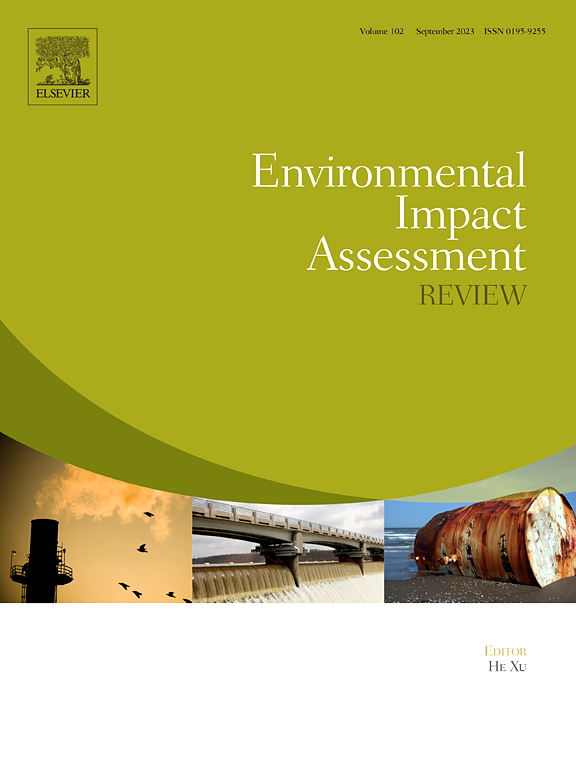Co-benefit or tradeoff? The impact of inter-provincial trade-embodied pollutants on air quality and public health under climate targets in China
IF 11.2
1区 社会学
Q1 ENVIRONMENTAL STUDIES
引用次数: 0
Abstract
Trade-embodied pollutants significantly impact air quality and and public health across regions, particularly under climate policy constraints, yet their transboundary health impacts via inter-regional trade remain underexplored. To address this, this study integrates a general equilibrium model, an air quality model, and health impact model to assess how interprovincial trade redistributes PM₂.₅ and health burdens between China's Chuan-Yu zone (Sichuan-Chongqing) and their trade partner regions under business-as-usual (BaU) and 1.5 °C scenarios. The findings indicate that CO₂ emissions in the Chuan-Yu zone follow an inverse U-shape pattern, peaking earlier under the 1.5 °C target than the BaU scenario, with Chongqing (133.94 Mt, 2017) achieving peak emissions 5–8 years before Sichuan (318.79 Mt, 2025). While SO₂ shows the sharpest decline, agricultural NH₃ remains challenging to mitigate. Trade shifts redistribute PM2.5 pollution under the 1.5 °C target, with Shaanxi, Liaoning, and Hubei as inflow regions and Shanghai, Beijing, and Jiangsu as outflow regions. Notably, PM2.5 concentrations rise in Jiangsu, Zhejiang, and Guangdong as they absorb production originally from Chuan-Yu. Stricter climate targets exacerbate spatial and temporal inequalities in Chuan-Yu's morbidity and mortality rates. Strikingly, health inequalities intensify spatially duto to trade, with Chongqing benefiting from shifted pollution burdens while Sichuan facing higher mortality. Stroke and ischemic heart disease (IHD) remain leading mortality causes, with significant reductions projected by 2060 in developed regions like Shanghai, Jiangsu, and Beijing, though the decline is slower in Inner Mongolia and Heilongjiang. The findings underscore the necessity for spatially differentiated governance, advocating for province-level pollution offset mechanisms and health compensation funds to address trade-induced disparities.
共同利益还是权衡?气候目标下中国省际贸易隐含污染物对空气质量和公众健康的影响
贸易包含的污染物对区域间的空气质量和公共卫生产生重大影响,特别是在气候政策限制下,但其通过区域间贸易产生的跨界健康影响仍未得到充分探讨。为了解决这个问题,本研究整合了一般均衡模型、空气质量模型和健康影响模型来评估省际贸易如何重新分配PM 2。在照常营业(BaU)和1.5°C情景下,中国川渝地区(四川-重庆)及其贸易伙伴地区之间的₅和健康负担。结果表明,川渝地区的CO₂排放量呈反u型分布,在1.5°C目标下比BaU情景更早达到峰值,重庆(13394 Mt, 2017年)比四川(31879 Mt, 2025年)早5-8年达到峰值。虽然so2的下降幅度最大,但农业NH₃仍然难以缓解。在1.5°C目标下,贸易转移重新分配PM2.5污染,陕西、辽宁和湖北成为流入地区,上海、北京和江苏成为流出地区。值得注意的是,江苏、浙江和广东的PM2.5浓度上升,因为它们吸收了原产自川渝的产品。更严格的气候目标加剧了川渝地区发病率和死亡率的时空不平等。引人注目的是,健康不平等在空间上因贸易而加剧,重庆受益于污染负担的转移,而四川面临着更高的死亡率。中风和缺血性心脏病(IHD)仍然是导致死亡的主要原因,预计到2060年,上海、江苏和北京等发达地区的死亡率将大幅下降,但内蒙古和黑龙江的下降速度较慢。研究结果强调了空间差异化治理的必要性,倡导建立省级污染抵消机制和健康补偿基金,以解决贸易造成的差异。
本文章由计算机程序翻译,如有差异,请以英文原文为准。
求助全文
约1分钟内获得全文
求助全文
来源期刊

Environmental Impact Assessment Review
ENVIRONMENTAL STUDIES-
CiteScore
12.60
自引率
10.10%
发文量
200
审稿时长
33 days
期刊介绍:
Environmental Impact Assessment Review is an interdisciplinary journal that serves a global audience of practitioners, policymakers, and academics involved in assessing the environmental impact of policies, projects, processes, and products. The journal focuses on innovative theory and practice in environmental impact assessment (EIA). Papers are expected to present innovative ideas, be topical, and coherent. The journal emphasizes concepts, methods, techniques, approaches, and systems related to EIA theory and practice.
 求助内容:
求助内容: 应助结果提醒方式:
应助结果提醒方式:


